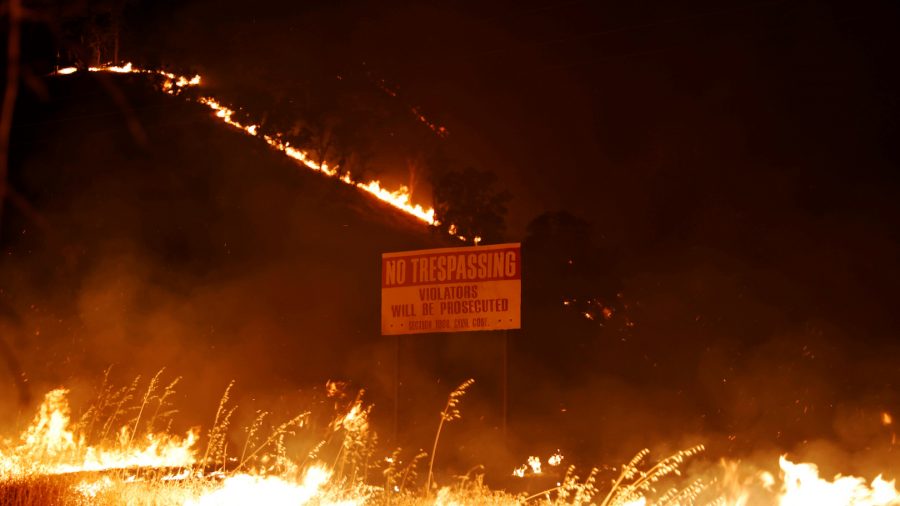VACAVILLE—Scores of homes burned in California on Wednesday as hundreds of lightning-sparked blazes forced tens of thousands of people to flee their dwellings.
Nearly 11,000 lightning strikes were documented during a 72-hour stretch this week in the heaviest spate of thunderstorms to hit California in more than a decade, igniting 367 individual fires. Almost two dozen of them have grown into major conflagrations, authorities said.
Multiple fires raced through hills and mountains adjacent to Northern California’s drought-parched wine country, shutting down Interstate 80 at Fairfield, about 35 miles (56 km) southwest of Sacramento, as flames leapt across the highway, trapping motorists caught in a hectic evacuation.
Police in the nearby town of Vacaville reported that advancing flames had prompted the evacuation of a state prison there and a medical facility for inmates.

Four residents whose communities were overrun by flames hours earlier in the same area suffered burns but survived, though the severity of their injuries was not immediately known, said Will Powers a spokesman for the California Department of Forestry and Fire Protection (CalFire).
He said thousands of residents were under mandatory evacuation orders in a four-county area stricken by a cluster of nine wind-driven fires collectively dubbed the LNU Complex, triggered by lightning on Monday.
In central California, a helicopter was on a water-dropping mission in Fresno County about 160 miles (258 km) south of San Francisco when it crashed, killing the pilot, a private contractor, CalFire said.

As of Wednesday night, the LNU complex of fires had burned largely unchecked across 124,000 acres (50,000 hectares), with zero containment, destroying at least 105 homes and other structures and leaving another 70 damaged, CalFire said. Several of the fires had merged by nightfall.
Wearing a singed nightgown, Diane Bustos said her husband abandoned their car as it caught fire and then blew up on the west side of Vacaville early Wednesday morning. She lost both her shoes when she and her family ran for their lives.
“I made it, God saved me,” Bustos told television station KPIX.
There were social media accounts of people trapped in the blaze, but CalFire’s Powers said authorities had no reports of anyone missing.


A Reuters reporter saw dozens of burned-out homesteads and houses in the Vacaville-Fairfield area, dead livestock among torched properties and some animals wandering loose.
“We are experiencing fires the like of which we haven’t seen in many, many years,” California Governor Gavin Newsom told a news conference, adding he had requested 375 fire engines from out of state to help.
He declared a statewide fire emergency on Tuesday.
The last time California experienced dry lightning storms of such devastating proportions was in 2008, said CalFire spokesman Scott Maclean.
Fanned by “red-flag” high winds, the fires are racing through vegetation parched by a record-breaking heat wave that began on Friday. Meteorologists have said the extreme heat and lightning storms were both linked to the same atmospheric weather pattern—an enormous high-pressure area hovering over America’s desert Southwest.
The largest group of fires, called the SCU Lightning Complex, had scorched at least 102,000 acres some 20 miles east of Palo Alto, while a third cluster, the CZU August Lightning Complex, grew to more than 10,000 acres and forced evacuations around 13 miles south of Palo Alto.
By Steven Lam
NTD staff contributed to this report.

